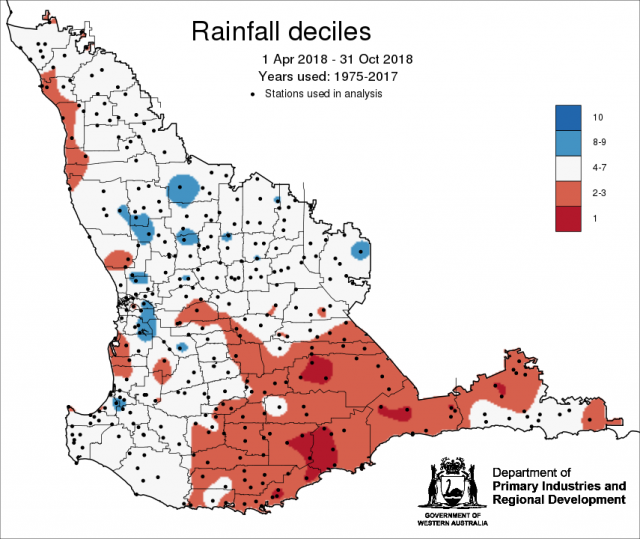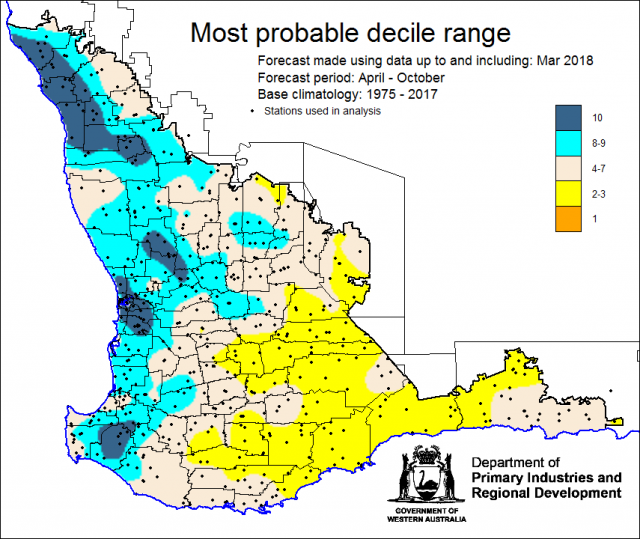Recent climate
October rainfall was generally average for the grainbelt. The last three months rainfall (August to October) was generally average to above average. In the August Seasonal Climate Outlook, the SSF and the Bureau model both indicated below median rainfall likely. October maximum temperatures were average to above average and minimum temperatures were very much above average. October maximum temperatures were average to above average and minimum temperatures were very much above average.
April to October rainfall in 2018 was generally average for the northern and central grainbelt and below average for the southern grainbelt. The SSF April to October decile rainfall outlook was correct for the southern grainbelt. This growing season, some stations received above average rainfall from localised systems from cloud band activity. Cloud bands develop quickly over a number of days (not months) and are therefore usually not identified by long lead statistical models such as the SSF.
In September, the atmospheric pressure was near normal over southern Australia, contributing to the average rainfall. The Indian Ocean sea surface temperatures continue to be cooler than average to Australia's north-west. This can lead to reduced rainfall, as less atmospheric moisture is available for rain-bearing weather systems.
The Southern Annular Mode (SAM), also known as the Antarctic Oscillation (AAO), describes the north–south movement of the westerly wind belt that circles Antarctica, dominating the middle to higher latitudes of the southern hemisphere. SAM is currently near neutral. The National Oceanic and Atmospheric Administration (NOAA) suggests that SAM is likely to go positive in mid-November. In a positive SAM event, the belt of strong westerly winds contracts towards Antarctica, resulting in weaker than normal westerly winds and higher pressures over southern Australia, restricting the penetration of cold fronts inland.
It is likely that a positive Indian Ocean Dipole (IOD) event is underway, as five of the past six weeks have exceeded positive IOD thresholds. The Bureau's model suggests positive IOD values will continue through October and return to neutral during November. A positive IOD typically decays in late spring or early summer. A positive IOD during spring typically reduces rainfall across much of the eastern two-thirds of Australia and can exacerbate any El Niño-driven rainfall deficiencies. During December to April, the IOD typically has little effect on Australian climate.See the Bureau of Meteorology’s IOD and Pacific Ocean interaction for details.
The tropical Pacific Ocean has been warming in recent weeks and currently the Bureau has issued an El Niño alert. There is approximately a 70% chance of El Niño occurring in 2018, around triple the normal likelihood, with El Niño likely to develop before the end of the year. El Niño typically results in below-average spring rainfall for northern and eastern Australia, and warmer days for the southern two-thirds of the country. By summer, the rainfall influence from El Niño contracts to the tropical north, while warmer days remain likely for large parts of the country.
The combination of El Niño and positive IOD increases the risk of heatwaves and bushfire weather in the south, while there are typically fewer tropical cyclones in the Australian region.
The table below gives a summary of past month and three month south-west Western Australia (SWWA) climate conditions, and can indicate what is likely to occur in the near future if climate conditions follow the current pattern.
| Climate indicator | Past month | Past three months |
|---|---|---|
| SWWA rainfall | Below average | Generally average |
| SWWA mean temperature | Average | Average to above |
| SWWA atmospheric pressure | Near normal | Near normal |
| Indian Ocean sea surface temperature | Cooler | Cooler |
| El Niño/Southern Oscillation (ENSO) | Neutral | Neutral |
| Indian Ocean Dipole (IOD) | Neutral | Neutral |
| Southern Annular Mode (SAM) | Near neutral | Near neutral |


